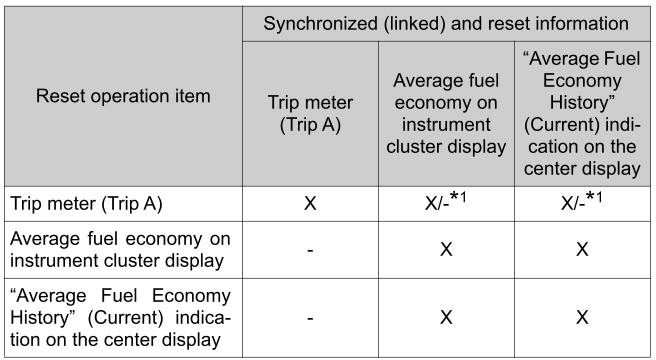Toyota Yaris: Fuel Economy Monitor (If equipped) / Fuel Economy Data Reset and Trip Meter (TRIP A) Synchronization (Linking)
Toyota Yaris XP210 (2020-2025) Owner's Manual / When Driving / Fuel Economy Monitor (If equipped) / Fuel Economy Data Reset and Trip Meter (TRIP A) Synchronization (Linking)
Because the average fuel economy indication on the instrument cluster display is linked with the “Average Fuel Economy History” (Current) indication on the center display, when one is reset the other is also reset.
In addition, switching between reset and no reset of the average fuel economy indication on the instrument cluster display and the “Average Fuel Economy History” (Current) indication on the center display when resetting the trip meter (Trip A) is possible.

X : Reset
- : Not reset
* 1 : Can be personalized. Refer to Customizable Features.
 Fuel Consumption Display
Fuel Consumption Display
Information regarding the fuel economy is displayed.
Displays the fuel economy for the past 60
minutes.
Displays the fuel economy every minute for
the past 1 to 10 minutes...
 Drive Selection
Drive Selection
Drive Selection (Automatic Transaxle)
Drive selection is a system to switch the vehicle’s drive mode.
When the sport mode is selected, vehicle’s response against
accelerator operation is enhanced...
Other information:
Toyota Yaris XP210 (2020-2025) Reapir and Service Manual: Removal
REMOVAL CAUTION / NOTICE / HINT CAUTION: Never perform work on fuel system components near any possible ignition sources. Vaporized fuel could ignite, resulting in a serious accident. Do not perform work on fuel system components without first disconnecting the cable from the negative (-) auxiliary battery terminal...
Toyota Yaris XP210 (2020-2025) Reapir and Service Manual: Backup Boost Converter "A" Circuit Current Above Threshold (P323A19)
DESCRIPTION A backup boost converter is built into the engine stop and start ECU. The backup boost converter helps maintain auxiliary battery voltage to prevent various functions from failing if power source voltage supplied from the backup boost converter drops due to the high electrical load when the engine is restarted by stop and start control...
Categories
- Manuals Home
- Toyota Yaris Owners Manual
- Toyota Yaris Service Manual
- Engine & Hybrid System
- Opening and Closing the Liftgate/Trunk Lid
- Maintenance
- New on site
- Most important about car
Break-In Period
No special break-in is necessary, but a few precautions in the first 600 miles (1,000 km) may add to the performance, economy, and life of the vehicle.
Do not race the engine. Do not maintain one constant speed, either slow or fast, for a long period of time. Do not drive constantly at full-throttle or high engine rpm for extended periods of time. Avoid unnecessary hard stops. Avoid full-throttle starts.
Copyright © 2025 www.toyaris4.com
